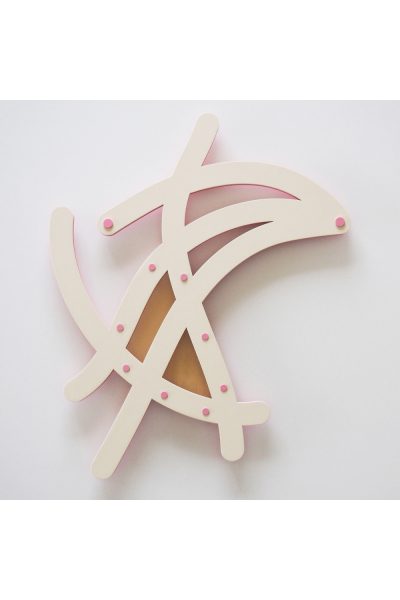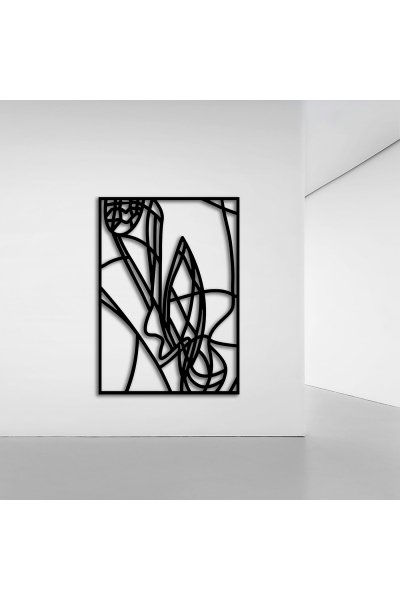TREASURES IN DETAIL
Petra: ‘The longer I drew, I started to see more and more the beauty of the inside, the guide lines that I have to draw to portray these drawings as perfectly as possible.
The inspiration comes from radiology. It's about the basics and what really matters in the end. You look at lines, the X-ray of my digital drawings.
You can discover additional things on an X-ray, such as ‘sunbeams’ or the density of your bones. I made blow-ups of a number of drawings and had them water-cut into metal together with authentic mouth-blown glass to emphasize the fragility, but also the power of nature.
I work with shadow and reflection, as is done in nature’.
Petra shows the external beauty and wondrous mathematics of nature and removes the limits of scale and materiality from her analog subject by transferring it to the digital world. With a great eye for detail, she makes a three-dimensional drawing, built up from a grid of vectors and colors of the chosen subject. This digital grid then forms the basis for a play of lines that shows the digital, vector interpretation of the natural phenomenon in materials such as metal (art) or silk (fashion), in combination with a color sample that the original once possessed.
To connect the digital and analog worlds, Petra uses modern computer techniques in combination with mouth-blown colored glass as a form of authenticity and as a complementary part of her computer drawings. Mouth-blown glass is a unique glass that retains fine air bubbles, presents an irregular surface and refines the light. The use of digital processes in combination with handmade glass creates a symbiosis between old and new.
COLOR IN LIFE, LIFE IN COLOR
The works of art show natural phenomena in an abstract composition of constantly changing shapes. The shapes and colors are inspired by the camouflage in nature of how we (believe to) see or not see something. Through experience, we have become accustomed to visual construction. This applies not only to color phenomena but also to depth and distance, shape and structure. Optical effects differ in color and brightness as well as in light and shadow and are due to radiation that differs in frequency and intensity. Another aspect is that there are living beings that use a completely different part of the electromagnetic spectrum while humans use three types of light-sensitive cells (RGB).
REVALUATION
To re-evaluate the beauty and richness of colors and shapes around us, we should show our environment in a new or unusual way, for example as a reverse color process, mono or duotone, infra-red, ultraviolet, X-ray or very simply: a photo upside down.
GOETHE
Goethe was the one who looked at color in a different way, stating that white light came from a combination of three light beams, red, green and blue. These three colors gave the following three colors cyan, magenta and yellow. Although magenta is an extra-spectral color without wavelength, Goethe showed that magenta becomes visible by placing an object between the light beam and the prism. Goethe imitated the earth and the sun (in miniature format, as it were) and placed a black circle between the light beam and the prism. As if the globe is between the sun and the ‘shadow side’. The first colors you see are blue and red and then magenta. In addition, he also showed the light beam through a prism with no black circle in between. The first colors you perceive are yellow and cyan and in the distance green. If you throw this duality back on nature, Goethe had a point.
RED, YELLOW, BLUE
Traditionally, in painting, the subtractive primary colors are referred to as red, yellow, and blue. These are the only three colors that cannot be obtained by mixing paint and they come from an outdated color theory from the eighteenth century, because with these colors it is not possible to mix a pure purple or green.
As a digital artist Petra works with light and her ‘color’ circles are wider and based on the electromagnetic spectrum. What we see and experience in nature is based on the full spectrum. What do you see or what do you think you see and what is reality, is there a reality?
CAMOUFLAGE AND RECOGNITION
There are various forms of camouflage or recognition in nature that make it extremely difficult to recognize different natural phenomena in their natural environment. The visible shape can only be distinguished if it is represented by differences in color or tone or in light and shadow: as those differences diminish, an animal or other object becomes more and more difficult to see: in its absence, it becomes unrecognizable. The phenomena that best fit into their actual habitat have the best chance of survival and reproduction.

Butterfly - Atrophaneura semperi albofasciata
€3.266,00
Petra shows the outer beauty and wonderful mathematics of nature and removes restrictions of scale a.....

Magnolia x soulangeana
€1.710,00
Petra shows the outer beauty and wonderful mathematics of nature and removes restrictions of scale a.....

Walking stick - Diesbachia tamyris
€4.480,00
Petra shows the outer beauty and wonderful mathematics of nature and removes restrictions of scale a.....

Eye of kingfisher
€7.000,00
Petra shows the outer beauty and wonderful mathematics of nature and removes restrictions of scale a.....



